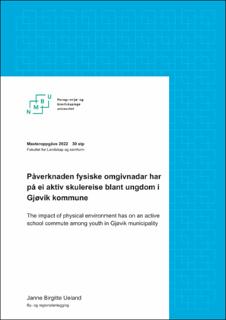| dc.contributor.advisor | Stefansdottir, Harpa | |
| dc.contributor.author | Ueland, Janne Birgitte | |
| dc.coverage.spatial | Norway, Oppland, Gjøvik | en_US |
| dc.date.accessioned | 2022-11-14T14:23:54Z | |
| dc.date.available | 2022-11-14T14:23:54Z | |
| dc.date.issued | 2022 | |
| dc.identifier.uri | https://hdl.handle.net/11250/3031750 | |
| dc.description.abstract | Gjennom masteroppgåva har ein forsøkt å svare på problemstillinga: «Korleis verkar dei fysiske omgivnadane langs skulevegen inn på reisemåten blant ungdom ved Vardal ungdomsskule i Gjøvik kommune?». Dette er gjort gjennom litteratursøk og kasusstudie med spørjeundersøking og romlege analysar. Litteraturstudiet var med å definere dei fysiske faktorane som verkar inn på aktiv reiseåtferd gjennom bruken av dei to første av Carmona et al. (2010) sine fire morfologiske element: arealbruk, gatestruktur, bygningsstruktur og eigedomsstruktur. I tillegg var litteraturstudiet med å definere kunnskapshòlet om ungdomar si aktive reise og påverknaden dei fysiske omgivnadane har på den. Dette gav samanlikningsgrunnlaget til resultata frå spørjeundersøkinga som blei gjort av ungdom ved Vardal ungdomsskule i Gjøvik kommune og dei romlege analysane frå området rundt skulen. I all hovudsak stemte funna frå eigne undersøkingar overeins med det tidlegare studie hadde funne, trass i at dei var gjort i storbykontekst andre stader i Europa. Den aktive skulereisa blir påverka av distansen ein må dra, og dei som har ei aktiv skulereise opplever skulevegen som grønare og mindre trafikkert enn dei som har ei passiv skulereise. | en_US |
| dc.description.abstract | This master’s thesis attempts to answer the question: “How do the physical environment on the school route impact the way youth commute to Vardal school in Gjøvik municipality?” This was done through search of relevant texts and case studies, including surveys and spatial analyses. The texts contributed towards a definition of the physical factors that impact active school commuting by using the first two of the four morphological elements named by Carmona et al. (2010): land uses, cadestral (street) pattern, building structures, and plot pattern. In addition, the texts helped fill the knowledge gap concerning active commuting patterns of youth and the impact of physical environment. This in turn lay the foundation for comparing results from the surveys of youth at Vardal school in Gjøvik municipality with the spatial analyses of the area around the school. For the most part, the finds from the surveys agreed with what earlier studies had found, despite the fact that these earlier studies were done in larger city contexts elsewhere in Europe. In conclusion, an active school commute is impacted by the distance one must travel, and those with an active school commute experience their school route as greener and less trafficked than those with a passive school commute. | en_US |
| dc.language.iso | nno | en_US |
| dc.publisher | Norwegian University of Life Sciences, Ås | en_US |
| dc.rights | Attribution-NonCommercial-NoDerivatives 4.0 Internasjonal | * |
| dc.rights.uri | http://creativecommons.org/licenses/by-nc-nd/4.0/deed.no | * |
| dc.subject | Walkability | en_US |
| dc.subject | Pedestrians | en_US |
| dc.subject | Physical environment | en_US |
| dc.subject | Morphology | en_US |
| dc.subject | Fotgjengere | en_US |
| dc.subject | Morfologi | en_US |
| dc.subject | Ungdom | en_US |
| dc.subject | Planning | en_US |
| dc.title | Påverknaden fysiske omgivnadar har på ei aktiv skulereise blant ungdom i Gjøvik kommune | en_US |
| dc.title.alternative | The impact of physical environment has on an active school commute among youth in Gjøvik municipality | en_US |
| dc.type | Master thesis | en_US |
| dc.subject.nsi | VDP::Samfunnsvitenskap: 200::Urbanisme og fysisk planlegging: 230::Landskapsplanlegging: 236 | en_US |
| dc.description.localcode | M-BYREG | en_US |

